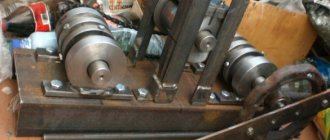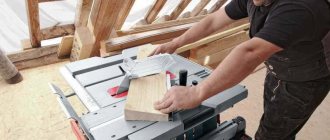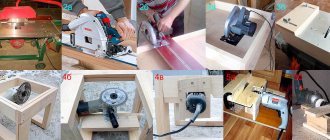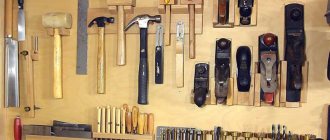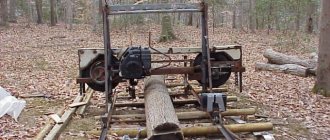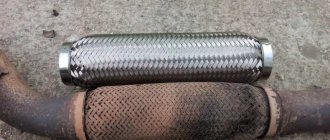One of the most important conditions for the normal development of plants growing in greenhouses is timely and high-quality ventilation of such structures, which can be organized automatically using a device such as a hydraulic cylinder. Having decided to install a device in your greenhouse that automatically opens and closes greenhouse vents under certain external conditions, it is not at all necessary to purchase it in a serial version: you can make a hydraulic cylinder with your own hands, using inexpensive components and available consumables.
Automatic greenhouse ventilation system based on a hydraulic cylinder
The “smart” greenhouse opens the windows itself
If watering, heating and ventilation in the greenhouse work on their own, the summer resident does not have to spend 24 hours with his vegetables. Automation installed in a greenhouse by a zealous owner will leave him more free time. Overheating of plants can destroy all the painstaking work of growing, because the seedlings will simply die. They vitally need timely ventilation. Let's look at how a “smart” greenhouse can open and close the windows independently, without human intervention.
Hydraulic cylinder for a greenhouse - installation and best brands (85 photos)
What a hydraulic cylinder is is known to many, but not to everyone. For those who are first faced with the need to acquire a hydraulic cylinder for their greenhouse, this equipment can be characterized as a reciprocating mechanism, which in this case helps maintain the optimal temperature in the greenhouse.
There are many types of hydraulic cylinders for greenhouses on sale, but you can make and install one yourself, especially since there are many solution options. The hydraulic cylinder, as a technical element, is used in many mechanisms, and therefore, to use it for greenhouse ventilation, you can remove it where it is no longer in demand, and also create a completely independent system.
Hydraulic cylinder for a greenhouse - what is it?
So, what is this mechanism and what is its function? The task that the hydraulic cylinder solves is to ventilate the greenhouse automatically. That is, you no longer have to worry, especially in the hot season, that the plants will overheat; for a person, this issue can be solved by a hydraulic cylinder.
What liquid should I use?
Any liquid is suitable for a hydraulic cylinder, but oil is the best option. Many people mistakenly believe that ether or alcohol increases the efficiency of the mechanism, but in reality this is not the case. Regular car oil, including engine oil, is quite sufficient. The simplest hydraulic cylinder for a greenhouse can be filled with a flushing composition with your own hands. If you don’t have the appropriate liquid at hand and you have to go to the store, then M8 oil products are suitable both in price and in terms of characteristics.
Purpose of a hydraulic press
After manufacturing, it is recommended to prime and paint the press. The test should begin with deformation of thin-walled products, gradually increasing the load.
If a cylinder and pump are used, their characteristics must be selected carefully. In particular, this refers to the maximum pressure value that can be used. It is not recommended to install homemade actuators. The same applies to models that were damaged but then restored.
Since using a jack to make a hydraulic press with your own hands is the best option, you can choose the simplest bottle-type model.
- This apparatus is mainly used to compress high and medium density objects, change their shape or displace liquid contained in the composition.
- In addition, the equipment can also be used to move heavy objects, but there is no need to buy a hydraulic press; you can make it yourself using a regular jack.
Hand-made pressing from a jack does not in any way affect its quality and technical efficiency. The characteristics are the same as those of the equipment that is produced in production. A hydraulic press can be used at home for many purposes. These include:
- stamping;
- forging;
- bending;
- extrusion of profiles;
- Clicking on different objects.
Pressing can also be used to package various wood, metal and plastic products.
A hydraulic press is used in almost every manufacturing facility, but it is also used at home. The advantage of this type of device is the law of hydrostatics, which, in turn, facilitates ironing products of any density.
- The principle of operation is that a hydraulic press applies pressure at one specific point and thus increases efficiency elsewhere in the plant.
- As a result, you can perform various actions from bending to squeezing an object with minimal effort.
- This way, you can perform various actions, from bending to pressing an object, with minimal effort.
The entire structure consists of a small number of parts, but the main parts are two piston cylinders that differ in diameter. Inside the pistons there is plain water or oil. The liquid allows the law of hydrostatics to operate.
This allows you to increase efficiency and the object will have a force of several tons. The design of a hydraulic press involves working in two planes, but the most common is a vertical type device, less often a horizontal one.
Should be considered
To make a hydraulic receiver from a steel pipe, turning and sealed, preferably gas, welding will be required. With a hydraulic cylinder working volume of 15 ml, a hydraulic receiver volume of about 600 ml is needed, which corresponds to a pipe with a diameter of 40 mm and a length of 400 mm.
Therefore, if you use a ready-made hydraulic cylinder, for example, from a combine, then keep in mind that its working volume is an order of magnitude larger, therefore the hydraulic receiver will be larger and more expensive.
You can fill the hydraulic automatic machine with oil after displacing all the air. In this case, at a temperature of 20–22 °C, the hydraulic cylinder rod must be completely retracted.
The tightness of the system must be ensured, since a change in the volume of oil due to leakage changes the setting of the hydraulic automatic machine. The tightness can be checked with air by pumping it with a regular foot pump for tires to a pressure of 6–7 atm.
Classic design
For production you will need:
The bottle lift itself;
- Channel;
- Steel sheet 4-5 mm thick;
- Two steel springs.
- The frame is welded from durable channel 5 mm thick. The corners are reinforced with brackets and anchors made of steel sheet of similar thickness.
Points of maximum pressure should be strengthened. To do this, the heels can be welded from a steel sheet. They are installed on the upper platform and on the moving element.
It is also recommended to install stops on the moving element to prevent the jack from slipping out.
The moving element is suspended on springs. Guide flags are welded to the ends, preventing vertical movement of the platform.
Construction is ready. The jack can be removed at any time and used separately from the press. Having a set of accessories (bushings, dies, first select the power unit with your own hands. A jack is often used for this. Its maximum load capacity determines the degree of pressure on the workpiece. The value of this parameter depends on the type of work being performed. For home use, you can choose a jack model with a load capacity from 7 to 20 tons.
Press with hydraulic cylinder and pump
An alternative option is to install a hydraulic cylinder and a pressure pump. This will ensure maximum comfort when doing work. But the cost of such a do-it-yourself design is much higher than that of a car with a jack.
The machine body is often made of steel channels and angles. The thickness of the material must be at least 2 mm. The design of a homemade hydraulic press with a jack or cylinder consists of the following components:
jack mounting block. Its movable rod can be placed in both the upper and lower parts;
auxiliary table. The workpiece will be installed on it. When making it yourself, it is recommended to provide for the possibility of changing the height relative to the jack;
Frame. A power unit and a support table are installed on it. At the bottom there are height-adjustable legs for greater stability.
It is not recommended to provide detailed construction drawings as different components may be used in its production. However, it is recommended that you familiarize yourself with the factory analogues in advance, based on the data received. in order to develop an optimal model.
Specially shaped fittings are used for various types of work. They must be made of durable tool steel, so making them yourself will be problematic. It is recommended to order from a professional turner.
Simple drawing of a hydraulic press
What is a hydraulic cylinder made of?
At the end of the cylinder, it is necessary to cut the ball so that as much of the holder length remains as possible. Then the cylinder is clamped using a vice, but this must be done through the ends so that the working element itself is not damaged. A 3-mm hole is made with a drill in a securely fixed cylinder.
When a hole is formed in the hemp, air will begin to escape under pressure. A slight “zilch” is possible and the risk of chips getting into the eyes cannot be ruled out - in this case, you must initially prepare glasses or a mask. Afterwards, the hydraulic cylinder for the greenhouses will be ready in the hemp. Next, a thread is formed on the hemp.
Culinary uses of a jack press
At the first stage, an accurate drawing is made, which should include all design elements. Their operational and technical characteristics are taken into account - overall dimensions, steel thickness, load capacity.
Before this, you need to choose the optimal set of tools and consumables. To process and weld metal structures, you will need a welding machine, a powerful drill, and a set of bolts and nuts. Blanks for a manual hydraulic press can be formed using a self-generator or an angle grinder. In order to secure the unit, holes will need to be made in its base.
Recommendations for assembling the machine:
Frame. The frame consists of 6 channels. The connection is made in two ways: welding and mechanically using screws;
auxiliary table. The optimal design is to install two channels with a gap between them;
Advantages and disadvantages
Among the advantages that a hydraulic cylinder used to provide ventilation of greenhouse premises in automatic mode has, the following should be highlighted.
- To operate such a device, it does not need to be connected to a power supply.
- A simple design scheme makes it quite easy to make a hydraulic cylinder for a greenhouse with your own hands.
- Such a device does not require constant maintenance.
An automatic ventilation system based on a hydraulic cylinder, despite some disadvantages, is quite often used in personal greenhouses
Naturally, such a device for automatically ventilating greenhouses also has disadvantages.
- When installing such a device on a window frame that rotates on a vertical axis, it is necessary to additionally use a return spring, since such a frame will not lower under its own weight when the volume of working fluid in the hydraulic cylinder decreases.
- If the air temperature drops sharply outside the greenhouse, the hydraulic cylinder will not close the window frame at the same moment; this will happen only after 15–20 minutes, when the oil in its working chamber has cooled.
Purpose and principle of operation
Overheating of plants growing in greenhouses can negate all the work that went into growing them. To avoid such situations, greenhouse premises must be regularly ventilated. It is especially important to perform this procedure in cases where the temperature inside the greenhouse reaches critical values. If you do not use a device such as a thermal drive for greenhouses (or a hydraulic cylinder), then constantly monitoring the temperature inside such rooms and ventilating the greenhouse yourself can take a lot of time, which could be spent more profitably. That is why any greenhouse owner who wants to make its maintenance process more efficient and less labor-intensive is seriously thinking about how to make a device for automatically ventilating greenhouses with their own hands.
The operating principle of a hydraulic cylinder for greenhouses is quite simple and is based on the law of physics, according to which a liquid, when heated, expands in its volume, and when cooled, it contracts, returning to its original state. Thus, if you place a liquid in a sealed cylinder equipped with a piston with a rod, then when heated it will begin to expand, which will lead to movement of the piston and, accordingly, the rod, which is rigidly connected to it.
The operating principle of the automatic greenhouse window opening system
Hydraulic cylinders for greenhouses, installed on the windows of such premises, operate according to the above scheme. As the air temperature inside the greenhouse increases, the liquid inside the hydraulic cylinder begins to expand and pushes out the piston of the device, imparting movement to the rod and the window frame connected to it, which will begin to open. When the air temperature in the greenhouse decreases, the system will begin to work in the opposite direction: the liquid will begin to compress and return to its original state, which will lead to the lowering of the piston with the rod and, accordingly, the closing of the greenhouse window frame.
How can such a simple system ensure the opening and closing of greenhouse window frames? Calculations show (and this is confirmed by practice) that a hydraulic cylinder with a diameter of 50–55 mm and a length of 50 cm with 800 grams of working fluid, which can be used as waste technical oil, is capable of automatically opening a window frame that weighs 10 kg.
Hydraulic cylinders can also be used to open greenhouse doors
Hydraulic cylinder from spare parts for a machine
For vertical vents, a mechanism assembled from scrap materials is ideal. It is capable of lifting even the heaviest frames, as long as the windows swing open along a horizontal axis. To create it, you need to improve the automobile gas piston.
You will need:
- the hydraulic cylinder itself. Its role can be played by stops for the trunk of Moskvich, Niva, Zhiguli (models VAZ 2108, 2109) or hydraulic cylinders from trucks that lift the cabin;
- epoxy adhesive;
- drill.
Hydraulic cylinder for a greenhouse from a car stop Work steps:
- Drill a hole in the bottom of the stop. Be careful and wear glasses when working. Gas escaping from the hole may carry chips into your eyes.
- Using a large diameter drill, increase the hole to 9 mm.
- We press on the rod and push it into the cylinder so that the piston remains at a distance of 30-35 cm from the hole.
- We degrease the resulting cavity with a solvent.
- After the cavity has completely dried, we prepare the epoxy glue for work.
- For greater convenience, the cylinder should be secured in a vice with the hole facing up.
- The piston must be lubricated with oil so that it does not touch the grease-free walls.
- Now let's create a glue plug. Pour glue into the cavity so that it completely covers the hole.
- After the glue has dried, the piston must be moved away by pulling the rod. Since it's oiled, it shouldn't stick.
- In the same place, only in the glue, drill a hole with a diameter of 9 mm.
- We cut threads in it in increments of 1.25 using an M10 tap.
- We strengthen the finished device under the window so that the rod lifts the transom when extended.
Horizontal hydraulic cylinder for greenhouse
Home use options
The use of a hydraulic press in a garage or home workshop is quite common. This type of press, which is small in size, can be used both for car repairs and for other types of work.
In particular, with the help of such compact equipment it is possible to press out bearings or silent blocks, as well as press new parts in their place. In addition to automotive repairs, a hydraulic press can be used for bending metal parts, creating the required pressure when gluing surfaces, briquetting waste, and squeezing out oil and liquid. Factory equipment for this purpose (even a manual hydraulic press) costs a lot of money, and not everyone can purchase it. Meanwhile, you can make such a press with your own hands, spending only money on purchasing the necessary materials.
Using a press as a juicer
What is noteworthy is that the design of a hydraulic press manufactured at home can immediately be adapted to solve a specific problem with a specific part or workpiece. A self-made press will not take up much space; to place it, it will be enough to allocate some space in a workshop or garage. Detailed instructions on how to make a hydraulic press are given below. There is also a video on this topic at the end of the article.
Do-it-yourself hydraulic cylinder
It's possible that you don't have a car part or a computer chair. Using the same principle, you can make a completely homemade system.
Advice. All connections must be absolutely tight, otherwise the design will not work.
To assemble you need to have:
- any bendable material, for example, polycarbonate or tin;
- plastic pipe;
- sealed chamber, you can use a ball;
- tools.
Do-it-yourself hydraulic cylinder for a greenhouse Steps of work:
- We create a container in the form of a cylinder ourselves, using bendable material. Plexiglas can serve as the bottom and lid. We attach it at our own discretion. Some people use tape, but it doesn't last long.
- We make the piston so that it moves freely in the cylinder, but sits tightly. It can be made from metal, plexiglass, wood treated with an antiseptic.
- You need to drill holes in the bottom and cover of the cylinder.
- A deflated rubber chamber from the ball must be placed inside the cylinder under the piston. Connect it to the tube and thread the tube into the hole at the bottom of the cylinder. As soon as the air temperature rises, the ball will inflate and push the piston.
- From the side of the cylinder cover, you need to insert a rod into the hole so that it fits snugly against the piston.
- Air will enter the ball through a tube coming from a separate container, that is, from the receiver. This could be a canister or paint can.
- It is better to pass two pipes through the receiver. One will attach to the ball in the cylinder. The other, spare, will serve for pressure regulation and calibration. It must be closed with a removable plug.
- Attach the rod to the window frame.
Calibration of this version of the device is possible using a free hose. By manually applying pressure, the hydraulic cylinder can be adjusted to respond to a specific temperature.
Converting a jack into a hydraulic cylinder
February 14, 2016
Hydraulic cylinders are used in plunger and drive type presses. The modifications vary in diameter. It is also important to note that most models have hinges. If we consider devices for plunger modifications, they use special sleeves.
The linings themselves are made of honed steel. If we talk about hydraulic cylinders for drive presses, they have pistons of different diameters. The lower part of the rod of the models is made with internal or external threads. On average, a high-quality hydraulic cylinder costs around 7 thousand rubles.
DIY model
An experienced milling machine operator will be able to make a hydraulic cylinder himself. A press (homemade), as a rule, is designed for a small load, so first of all, a small diameter piston is selected for assembly. Next, a trunnion is welded to it.
In order to hold the pad in place, sleeves are used. Next, to make a hydraulic cylinder for the press with your own hands, you will need a bushing. It should be attached to the piston. The average rod diameter is 60 mm. If we consider modifications for drive presses, then special bonks are soldered at the end of the cylinders.
Devices for 20 tons
Hydraulic cylinders of this type are manufactured for both plunger and drive presses. Their pistons are installed with a diameter of up to 50 mm. The cylinders themselves are made of heat-resistant steel.
Some configurations have a special seal. The thickness of the journal in this case depends on the width of the piston. The hinges for such models are of the spherical type. Some models have an intermediate stop.
On average, such a hydraulic cylinder costs about 7 thousand rubles.
30 ton models
Hydraulic cylinders for a 30-ton press are in demand at industrial enterprises for stamping various utensils. Many models use damped pistons. The rod itself is installed with a diameter of about 60 mm. A hydraulic cylinder of this type weighs around 22 kg. The rod is used without fastening.
Modifications for drive presses have a sleeve. Its diameter is adjusted to the piston. Flanges in all configurations are mounted on special feet. It is also important to note that hydraulic cylinders without a trunnion are available on the market. Their linings are made of honed steel. You can buy the model in stores at a price of 5 thousand.
rub.
Devices with welded stem
Hydraulic cylinders for this type of press are produced with a small diameter. Model pistons are usually designed for 20 tons. Some configurations use screw-mounted cylinders.
It is also important to note that there are modifications on the market with bonks. They are located at an angle of 90 degrees.
The average weight of a hydraulic cylinder and pump for a press of this type is around 20 kg, and it costs about 7 thousand rubles.
Application of wide flanges
Hydraulic cylinders with wide flanges are in demand in print media. On average they are designed for 30 tons. In this case, the rods are used from heat-resistant steel. For some modifications, the piston is installed with a large diameter. It is also important to note that there are hydraulic cylinders that have a protective sleeve. Such devices weigh around 25 kg.
The sleeves for all models are located under the rod. The flanges are installed directly in the sleeve. Seals in devices are used with special paws. Trunnions are absent in almost all modifications. Nowadays, high-quality hydraulic cylinders cost around 8 thousand rubles.
Models "Miol"
Hydraulic cylinders of this series are designed for a load of 25 tons. The piston of this model has a diameter of 50 mm. The rod in the device is of a welded type. According to the owners, the piston stroke of the hydraulic cylinder is no more than 70 mm. The bonks in the presented device are located at a slight angle. The cylinder itself is of the damped type.
Due to the special coating, the piston is able to withstand high temperatures. Today, these models are often installed on drive presses. The user can buy a hydraulic cylinder for a press (hydraulic) at a price of 5 thousand rubles.
Characteristics of the Thorin model
These hydraulic cylinders for the press can withstand loads of up to 20 tons. According to the owners, pistons wear out very rarely. However, it should be noted that the rod in the device is installed of a damped type. The bonks of this model are located at an angle of 50 degrees. The cylinder used is a standard honed type. There is no cover under the sleeve in the presented model.
If you believe the reviews of the owners, then this hydraulic cylinder is not suitable for drive presses. It is also important to note that the model’s flange wears out quickly. Its thickness is 2.3 mm. It is installed immediately above the seal. According to the documentation, the piston diameter is 55 mm. This model does not have hinges. The user can purchase the specified hydraulic cylinder at a price of 6 thousand rubles.
Opinions about TS models
These hydraulic press cylinders are only available with steel pistons. At the same time, they have high-temperature linings. All this indicates low wear of the product. It is also important to note that the device can withstand heavy loads. According to the owners, the model can be installed on presses with a load of up to 20 tons.
The device uses two seals. The pad it uses is of a damped type. The cylinder itself is installed above the sleeve. If you believe the reviews, it rarely gets deformed.
The flange in the device is set to a small width. The sleeve is standardly used with a fastener. In this case there is no eyelet.
The user can buy the presented hydraulic cylinder for a hand press at a price of 8 thousand rubles.
Reviews of hydraulic cylinders "Line"
The specified hydraulic cylinder receives positive reviews from consumers. In this case, the piston stroke is at 66 mm. The seal itself is of small thickness, but it wears out slowly. According to the owners, the sleeve used in the device is durable. The maximum load it can withstand is 30 tons.
The overlay of this model is made with a heat-resistant layer. The cylinder is usually of the damped type. The bonks of this model are at a slight angle.
According to the documentation for the device, the specified hydraulic cylinder has two flanges. One of them is located at the base of the sleeve. The other flange is located at the piston itself.
The hinges of this model are of the spherical type. The model's stem is mounted on a special mount.
The trunnion installed in the device is small. The total weight of this hydraulic cylinder is 33 kg. This modification is only suitable for drive presses. In this case, the piston diameter is 54 mm. The user can purchase a hydraulic cylinder at a price of 11 thousand rubles.
Manufacturing of a greenhouse hydraulic cylinder
Required tools and materials:
- tin or polycarbonate (a piece should be enough to make a cylinder Ø200 mm);
- scotch;
- sandpaper;
- a piece of plastic pipe;
- sealed chamber;
- hacksaw;
- drill.
Assembly sequence of cylinder, rod and piston
Examples of automatic solar opening of vents in a greenhouse.
A cylinder bent from tin or polycarbonate can be fastened with regular tape. There are many options, it is unnecessary to consider them. The length of the cylinder should be between 30 and 35 cm. The lower part must be sealed with foam. If the cylinder was made of a plastic pipe, you can use penoplex for the plug, but preference should be given to plexiglass with a thickness of at least 5 mm.
Cut two circles from the plexiglass that are large enough to cover the cylinder. A plug for the hydraulic cylinder will be made from one circle, and a guide for the rod will be made from the other.
The piston can be made of foam or the material from which the plug was made. The main condition for selection is sufficient strength and rigidity. The diameter of the structure must be such that the piston passes freely in the cylinder. It can also be made from wood; for the rod, plan and sand a piece with a length of 500 mm and a diameter of 40 mm using sandpaper. To prevent the tree from swelling, treat it with a protective agent. Otherwise, the part can be made from a piece of size 32 plastic pipe.
Drawing and concept of a jack press
Power elements are made of steel with a thickness of at least 15 mm or from steel profiles. As vertical struts, you can use a dowel, angle, profile pipe or the same channel. It is preferable to use a threaded rod, as it allows you to quickly adjust the size of the working area.
It is this diagram that we will take as the basis for understanding the design.
Two threaded rods (4) at the bottom (5) and at the top are screwed into the base (7) with a thickness of 20 mm, which allows you to adjust the height of the upper platform.
The pins (4) are made of a steel wheel with a diameter of 30 mm. The upper thread is cut based on the lifting height of the jack rod with a small margin.
The hydraulic jack (6) is installed on the base.
Popular: Homemade pipe bender how to make at home
It would be advisable to fix it there. The bracket is removable to use the lift for its intended purpose.
The lower platform (3) moves vertically on pins.
If the metal thickness is insufficient, the holes can be reinforced with sleeves to prevent tipping. The upper feed platform (1) is bolted with reinforced nuts (2), which are used to adjust the height of the working area.
As a result, the following power structure is created:
This is by no means an axiom; the formula can be anything, especially. Drawings will be developed depending on the availability of material and the type of hydraulic jack used.
The operating principle is as follows: dies (sleeves, punches) or other devices are installed on the platforms, between which the workpiece will change its shape. The jack is lifted in the traditional way - a force equal to the lifting capacity of the jack acts between the platforms.
In industrial construction, a separate hydraulic cylinder and a hydraulic pump are connected to each other by a supply line. This is convenient because it makes the design compact, and the use of a manual pressure pumping system is more convenient.
Construction of a homemade garage press: design characteristics
Before making a hydraulic press, you should decide on the type of installation. Depending on this, the equipment can be desktop or floor-standing. The first type of tool is located on a workbench, and the second is placed on a special pedestal. Such presses differ in size and load capacity. A self-made tabletop hydraulic press provides a force of up to 12 tons, and for a floor-mounted device this value reaches 25 tons.
The desktop design is more stable and mobile. Thanks to its small size, it does not take up much free space. This type of press is used for processing small workpieces.
The floor-mounted hydraulic press is characterized by its large size and heavy weight. To install it, you will need to build a special platform. Such a machine will cope with processing large metal elements, disassembling and assembling complex components.
A self-made hydraulic press for a garage can have a vertical or horizontal design
Important! To expand the functionality of a floor-mounted hydraulic press, it should be equipped with an electric motor.
You can make a complex structure that will be used to perform a wide range of tasks. However, making such an option will take a lot of time and require the use of specialized tools and equipment. As a garage hydraulic press, it is better to make a manual model equipped with a hydraulic pump and drive. This design is two-speed, its piston is characterized by mobility.
A self-made hydraulic press for a garage can have a horizontal or vertical design. The first type of device is used for straightening, cutting and bending individual metal elements. Vertical equipment is designed for unpressing and pressing parts. A self-made hydraulic press for waste paper is becoming increasingly popular.
The design of a manual hydraulic pump and its operating principle
The simplest to set up and operate is a manual hydraulic pump. It is based on the principle of fluid displacement. In industry, such units are quite in demand; their main function is pumping fuels and lubricants.
Hydraulic hand pump
Design and diagram of a manual hydraulic pump
Diagram of a hydraulic hand pump
The manual hydraulic pump consists of two main parts, the pumping unit (1) and the hydraulic tank (2). They are connected to each other by a pin (3). You need to fill the liquid through the hole, having first unscrewed the plug that closes it (4).
The handle (6) with the lever (7) drives the plunger (8) of the first and second stages, made as one part. The pumping unit has a two-stage structure. Stage number one, with reduced pressure and higher productivity, serves to accelerate the movement of the hydraulic cylinder plunger.
Stage number two, at high pressure and lower capacity, serves to obtain the operating force of the actuator. Overload protection is provided by a safety valve (9).
Pressure is released and hydraulic fluid is extracted from the cylinder cavity into the tank using a screw (10).
Working principle of a manual hydraulic pump
Before starting to work with any pump, be sure to inspect the tool and if cracks and chips are found on the surface, do not use it. It is important to check whether the high pressure hose is tightly connected to the hand pump.
Work algorithm:
- We connect the pump to the hydraulic system with a quick-release coupling;
- Turn the valve all the way clockwise.
- Using progressive movements, pump the pump handle up and down. As a result, oil is pumped into the system from the pump. At the same time, pressure builds up in the system, and the piston of the hydraulic tool moves, into which we pump oil.
- In a situation where the working piston of the system into which oil is poured reaches its final position, increased pressure will be created in the system, as a result it will be impossible to pump oil. Then it is necessary to stop the pump to avoid failure of the device.
- In order to lower the pressure in the system, you need to slowly turn the valve all the way counterclockwise. As a result, oil from the system will flow back into the pump. This occurs due to the return of the piston to its original position.
- After finishing pumping oil, you should inspect the hydraulic system for oil leaks, and you should also inspect the pump. If leaks are found, they should be corrected immediately.
Malfunctions and their elimination
- The manual hydraulic pump does not supply pressure. The main reasons for this behavior may be the lack of hydraulic fluid in the tank or the drain valve is not closed. In any case, it is worth checking these versions; if the tap is still closed and there is liquid, then perhaps the reason is that the suction or discharge valve is clogged. Then you will have to disassemble and wash the hydraulic pump valves.
- Oil (hydraulic fluid) is leaking in the gap located between the body and the plunger. In this case, it is highly likely that the O-rings are worn out or damaged. It is recommended to replace them immediately to prevent failure.
- Does not produce the performance specified in the data sheet. Most likely the filter element of the manual hydraulic pump is clogged. It is recommended to thoroughly rinse the filter element.
- Does not develop the pressure specified in the technical data sheet. The safety valve is not adjusted correctly. You need to set the safety valve to the pressure indicated in the data sheet.
How to choose the right hydraulic manual pump?
Three main selection factors:
1. The hydraulic pump tank must be larger than the hydraulic cylinder capacity.
2. Manual hydraulic pumps come in two types: single-acting and double-acting, pay attention to this parameter.
3. The pressure level should match what you need for work. Select a hydraulic pump with a pressure equal to or greater than the maximum pressure of the hydraulic cylinder.
Is it worth making a manual hydraulic pump yourself?
At the moment, hand-made pumps are almost never found. Despite this, you can make a hydraulic pump with your own hands. We will need a steel tank. The body will be made from it. To control the pressure in the tank you need a valve. It needs to be secured at the top with a washer.
A lever is installed to control the closing valve. A cast iron pipe may be suitable. Use a pressure gauge to monitor pressure. In the end, you will end up with a device that will not withstand pressure of more than 4 atmospheres.
With all this, a homemade hydraulic pump will take up a lot of space and be inconvenient to carry. The disadvantage of homemade hand pumps is their low efficiency; quite a lot of force will be required to activate the pump. Also, homemade devices are very unreliable.
And if you take into account all the disadvantages, then spending resources on creating a homemade manual hydraulic pump is very ineffective. That is why they are not common.
Manual hydraulic pumps NRG
NRG hydraulic pumps are very reliable devices and are very common here in Russia as they are produced here. The NRG line of pumps contains devices with distributors.
The letter “P” is usually placed at the end of the designation of such instruments. This letter means that the tool can work with double-acting hydraulic devices.
Let's consider several models of NRG manual hydraulic pumps:
- Model nrg-7020R. Creates a maximum pressure of 700 bar. And it has a nominal tank volume of 2 liters. The kit includes a hydraulic distributor that allows you to work with both single- and double-acting devices.
- Model nrg-7007. Also creates a pressure of 700 bar. The nominal tank volume is 0.7 liters. The advantages of this model are the presence of a safety valve, minimal force on the handle, and two stages of oil supply. This tool is designed for single-acting hydraulic tools with a spring return rod.
- Model nrg-67016R. The nominal tank volume is 14 liters. Handle force 55 kg. Pressure maximum 4 MPa. Capacity is 115 cubic cm. Such a device weighs as much as 30 kg and is quite large. Suitable for a small car service.
Summary, pros and cons of hydraulic hand pumps
Pros:
- Easy to use;
- Do not require any additional energy source;
- High maintainability;
- Have high mobility;
Minuses:
- Low performance;
- Muscular strength of the operator is needed, therefore, additional load on the operator;
Bottom line, it is reasonable to use a manual hydraulic pump in small workshops and mobile services, where there is no need to pump in large volumes of oil and build up significant pressure. In general, hand pumps are very convenient, and most importantly, they are mobile since they do not depend on any energy sources.
The design of a manual hydraulic pump and its operating principle Link to the main publication



